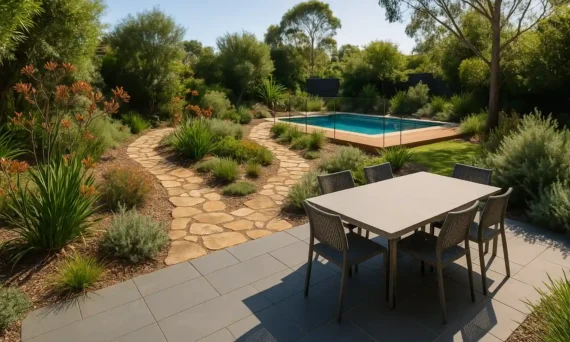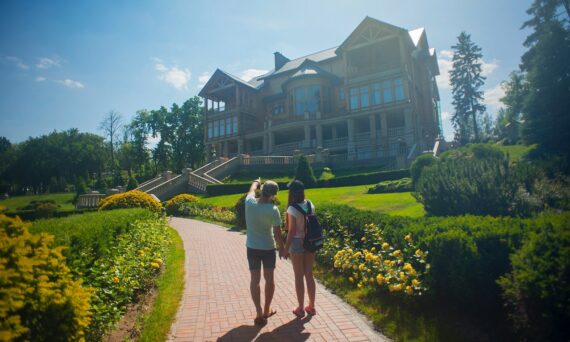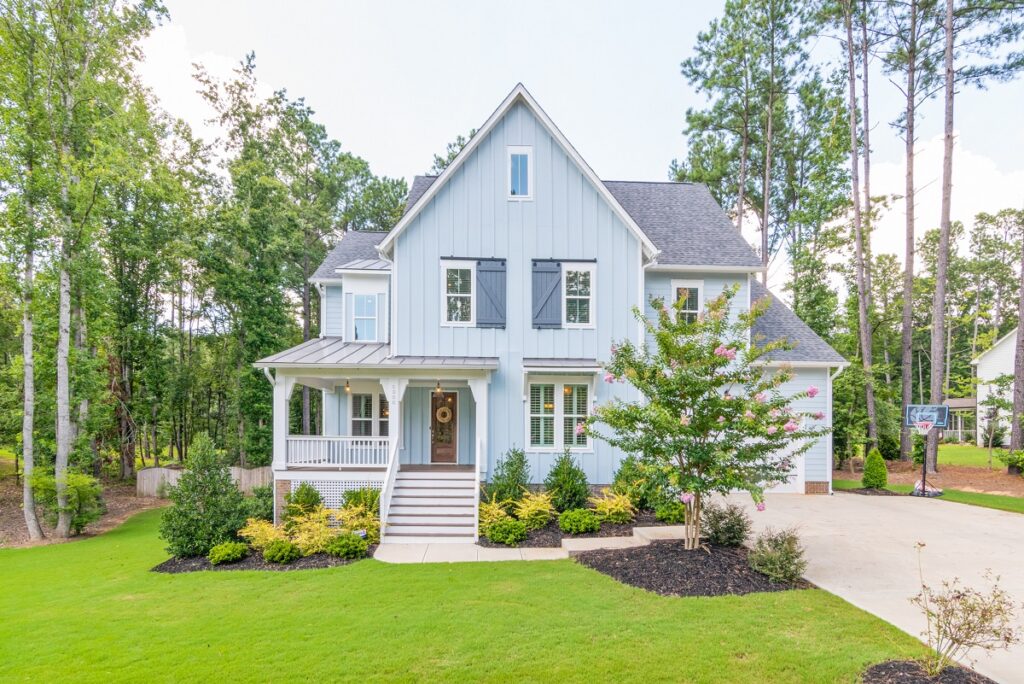Everything You Need to Know About Paving Options for Your Garden
Garden paving types create structure, define spaces, and tie your whole outdoor design together. If you’ve ever wondered why some Australian gardens feel like luxurious outdoor rooms, there’s your answer.
You have multiple options to choose from for your garden paving. But the best paving can change how you use and enjoy your garden entirely. We’ve worked with Australian homeowners and seen the way the right material choices completely changed a place.
In this guide, we’ll walk through the most popular outdoor paving options available across Australia. You’ll learn which materials work best for different climates, budgets, and design styles. We’ll also compare the cost, durability, and maintenance of all the available paving options.
Ready to find the perfect foundation for your dream garden? Read on to learn more.
Popular Garden Paving Types Explained
If you go to any garden centre, you’ll usually see the same two paving types there: natural stone and concrete pavers. And you find these pavers everywhere because they work well for most jobs.
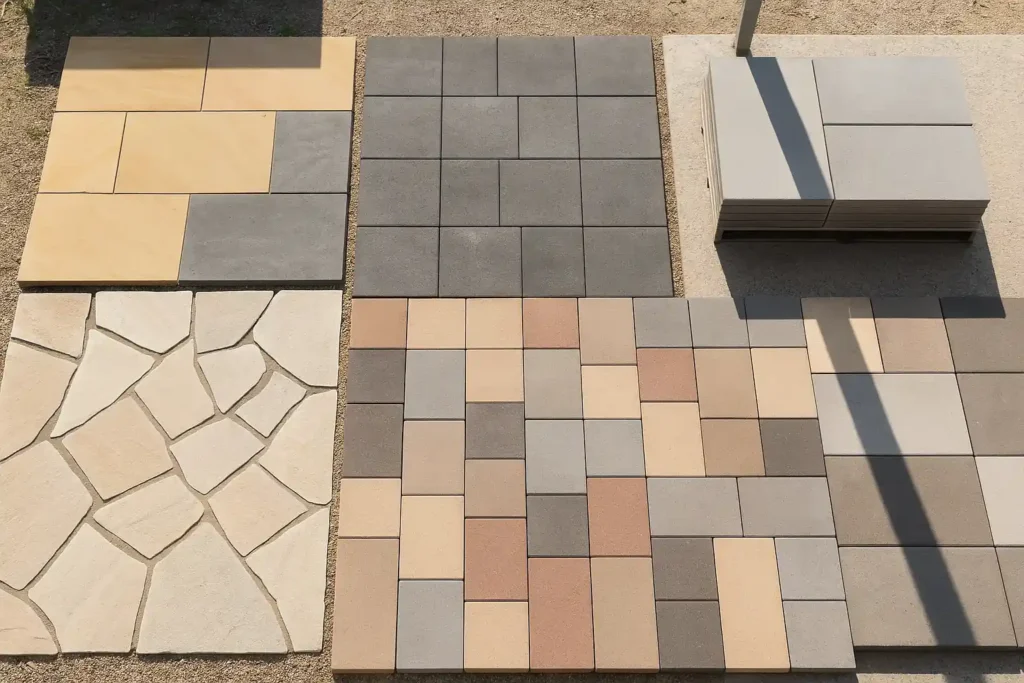
With the natural stone option, you get an authentic, earthy ageing feel. Meanwhile, concrete pavers come with flexible colours and patterns you can’t get from quarried materials (natural stone is great, but it doesn’t come in neon pink, you know).
These fundamental differences can help you understand what works best for your garden’s style and practical needs.
Let’s see what natural stone and concrete pavers mean for your day-to-day life.
Natural Stone Pavers: Timeless Beauty
Mother Nature spent millions of years creating these materials, and it shows. Every piece carries unique grain patterns, subtle colour variations, and texture. These characteristics are hard to manufacture.
But do you know the best part of natural stone pavers? They develop character over time instead of looking worn out. Particularly for this reason, many people can’t avoid the strong appeal of natural pavers and decide to go with this option.
You can use natural stone pavers in two ways, and here’s a detailed discussion on them both.
Sandstone and Bluestone Options
Australian stone choices usually come down to sandstone versus bluestone. Sandstone’s warm honey and cream tones stay cool underfoot during summer. They’ll cost you between $90 and $130 per square metre.
However, bluestones offer dramatic cool greys and charcoal colours for modern gardens. Is this what you love? Then you’ll need to pay $120 to $180 per square metre for these pavers.
Crazy Paving Aesthetics
Crazy paving involves using irregular stone pieces to fit together like a jigsaw puzzle. It’s a completely different approach from the previous traditional one. It also creates a wonderful flow and visual interest that regular patterns can’t match.
This technique works best in curved areas like winding pathways or garden borders, where those irregular pieces can follow organic lines naturally. Crazy paving stands as a budget-friendly option too, costing you $70-$110 per square metre.
Concrete Pavers: Versatile and Practical
Modern concrete paving maintains incredible consistency through a controlled manufacturing process. That’s why these pavers are often more affordable. Manufacturers can also add features like improved drainage and slip resistance to the pavers if needed.
The information below will help you decide on your concrete pavers.
Styles and Paver Colour Choices
You get endless design possibilities with concrete pavers. Based on your preference, manufacturers can create textures mimicking natural stone, timber, or brick at a fraction of the cost of their organic counterparts.
Not only that, but concrete paver is probably the most budget-friendly option for you, too. If you consider standard coloured pavers’ pricing against basic grey pavers’, you’ll need to pay $5-$15 per square metre extra. That’s it.
Large-Format Pavers Appeal
Large-format pavers (600 mm x 600 mm or larger) make your spaces feel bigger due to their size. It means you have fewer joints to deal with, which gives you a smoother visual appearance. Their prices range from $45 to $75 per square metre.
Modern Garden Paving Alternatives
Sometimes you need to think outside the usual stone and concrete options, and that’s where things get interesting. Modern gardens are turning to paving materials that handle specific challenges better (e.g., dealing with wet climates or working around curved pathways).
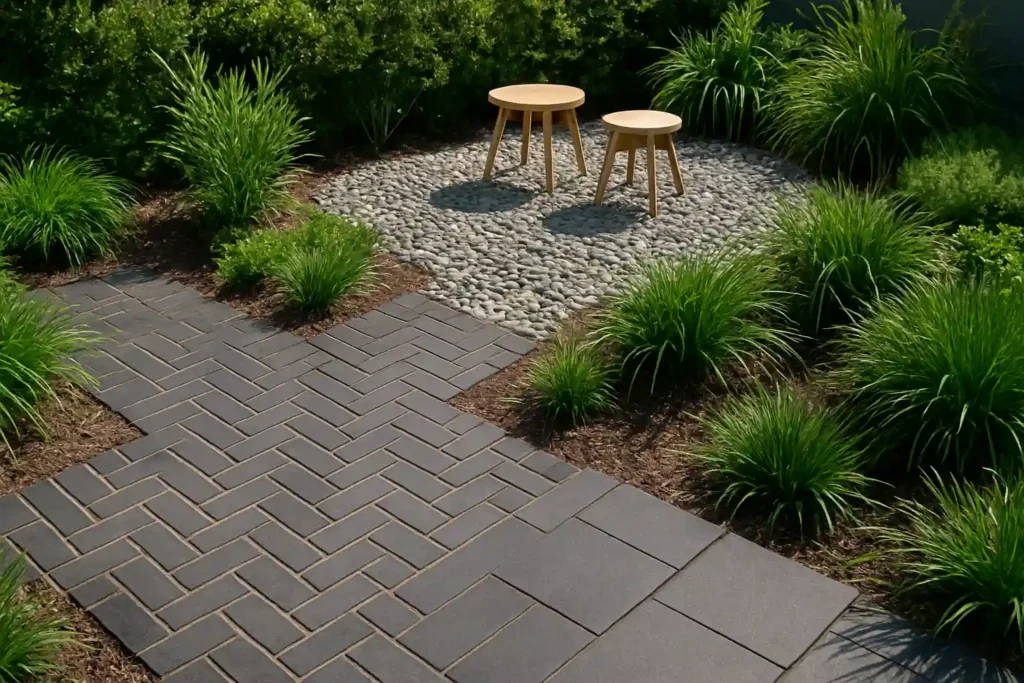
However, what’s truly appealing about them is the way these alternatives cost considerably less than the traditional pavers. This cost-cutting opportunity opens up possibilities for larger projects without stretching your budget (well… broke homeowners deserve nice things too!).
And you have quite a few options available to you from modern alternatives like brick and loose stone pavers. Keep reading to get more detailed information on them.
Brick Pavers: Classic and Durable
Brick has been paving pathways for centuries, and there’s a good reason it never lost its attraction. The fired clay construction of those bricks creates durable surfaces that get better with age.
And if you are interested in creating intricate patterns, such as herringbone or basketweave, to add a visual punch to your gardens, brick pavers offer you the exact chance to do so. Not to forget either, bricks work well around curves too, since they are smaller in size.
But you’re probably wondering if all those facilities come with an expensive price list. Simple answer: no. Brick pavers will cost you between $45 and $70 per square metre. It’s a good option between concrete and natural stone pavers if you think about it.
Choose your brick pavers from the list below:
- Traditional Red Bricks: Classic red clay brings instant heritage charm with warm, earthy tones that work beautifully with aged homes and cottage gardens. The slightly rough surface of red bricks provides great grip and develops a lovely patina over time.
- Newer Colour Ranges: Modern manufacturing has opened things up well past traditional red. You’ll find creams, charcoals, browns, and even purple colour options suitable for contemporary schemes while keeping that classic brick character.
- Permeable Brick Options: Specially designed versions like these let water filter through joints or the brick itself. It is brilliant for areas with runoff issues or where councils demand permeable surfaces.
Loose Stone: Natural and Flexible
Loose stone materials are incredibly flexible and drain water naturally. Unlike permanent paving, you can easily move, replace, or change them as your garden needs to grow. They work perfectly for casual walkways or garden borders where you want a softer, more natural look.
Let’s find out where loose stone pavers work best:
- Gravel and Pebbles: In terms of size, you’ve got fine gravel (best for areas with foot traffic) as well as large river stones with this option. Gravel and pebbles improve your drainage while adding texture to your space. And if you’re concerned about their appearance, river pebbles come with a smooth, rounded shape in greys and browns.
- Decorative Aggregates: Coloured glass pebbles, polished stones, and specialty aggregates draw attention like nothing else. Premium options like these can change your ordinary garden beds.
Your local landscape supplier probably has samples you can feel and compare side by side. Be sure to ask them for those samples before you make your decision.
Selecting the Best Paving for Scenery
Look, you may feel overwhelmed staring at dozens of paver samples and listening to hundreds of conflicting pieces of advice. But here’s a secret to maintain your focus and assess your needs properly: work backwards from your actual needs rather than getting caught up in what looks pretty in the showroom.
“But how do I do that?” you ask. It’s a good question. You can start your assessment by figuring out how you’ll use the space and how much maintenance you’re realistically willing to do. Then consider your home’s architectural style and existing garden elements.
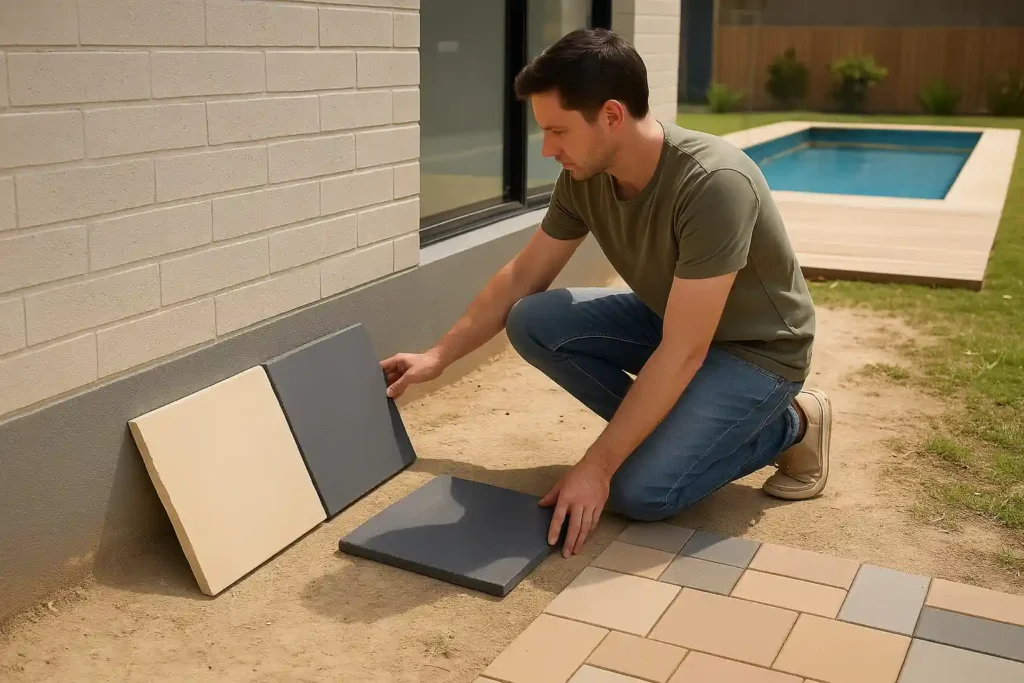
This breakdown will help guide your decision-making process.
Functionality and Usage Considerations
Think about what your paved area truly needs to handle each day. If you’re paving around the pool, you’ll want slip-resistant surfaces that won’t burn your bare feet. But for your driveway, you’ll need your pavers to handle the weight of cars without cracking.
Don’t forget to consider your local climate, either. Because some materials can tolerate the Australian summer sun, while others fade or crack under pressure.
You should also be careful with your colour choices. For instance, light-coloured concrete and pale sandstone show every coffee spill and muddy footprint (light colours are beautiful until you have to live with them).
So, factor in your tolerance for constant cleaning. Ask yourself if you’re ready for it.
Aesthetic Balance and Style
Your paving should always match your home’s style naturally. Think about federation homes. They look great with warm sandstone or traditional brick, but modern houses work well with large concrete pavers or sleek bluestone options.
To avoid creating a clash between your existing style and new pavers, look at the colours that are already present on your house exterior. You want your paving to flow smoothly between indoor and outdoor spaces.
Sustainable Paving Choices in Australia
Let’s get this straight. Australian gardens face unique challenges like water shortage, intense heat, and pressure on natural resources. That’s why, if you’re mindful about your paving choices, you can solve these problems easily instead of making them worse.
For our rough environment, sustainable paving options can prove to be the most useful. They’ll also reduce impacts on the climate, because the right materials will support natural water cycles, reduce heat in the urban area, and use fewer new resources.
Based on our experience, eco-friendly paving often gives you better long-term value through less maintenance and improved performance. Such paving choices meet council requirements for sustainable development, too. It’s a win-win situation.
Here’s how you can contribute to making the world more environmentally friendly by using sustainable pavers:
- Recycled Materials: Durable pavers made from recycled glass, plastic, or rubber keep waste out of landfills. You can get recycled concrete pavers for around $30-$50 per square metre, and they work just as well as new materials.
- Local Sourcing: Why ship materials across the world when you can source locally? Australian sandstone and bluestone from within your state often cost less than imported alternatives while supporting local jobs.
- Water Management: Permeable pavers let rainwater filter through instead of creating runoff. This convenient feature takes pressure off stormwater systems and helps recharge groundwater naturally. You’ll have to pay an extra $10-$20 per square metre, but council rebates in water-sensitive areas might lower your cost.
- Cool Paving Options: Light-coloured materials reflect heat rather than absorbing it. Take cream sandstone pavers, for example, which can stay up to 15 degrees cooler than dark surfaces. Using these pavers reduces urban heat and makes your summer entertaining spaces much more comfortable.
Think your council will be impressed when you’re the first on your street to tick all their sustainability boxes?
Cost-Effective Paving and Maintenance
Your paving decisions should always balance upfront costs with long-term expenses, and here’s why it’s important. The cheapest material isn’t always the most economical when you factor in installation complexity, durability, and ongoing maintenance needs.
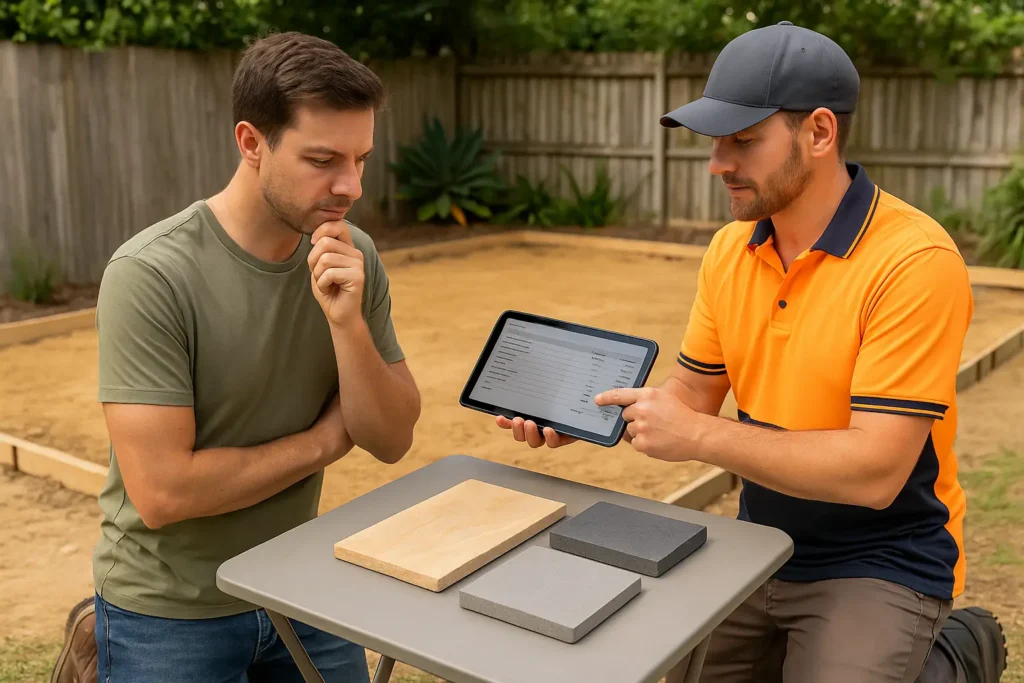
Some materials require professional installation, while others work fine as DIY projects. This difference affects your total investment significantly. Throughout the years, we’ve learnt that looking at costs over 10-15 years gives you a much clearer picture than just comparing initial prices.
The goal should be to find the sweet spot where upfront investment, expected lifespan, and maintenance requirements all line up with your budget and lifestyle reality.
We’ll start with your paving cost.
Understanding Paving Costs
Material costs are just one piece of your total investment calculation. Labour typically adds $40-$80 per square metre for professional installation, and that figure changes based on how complex your job is and how easily contractors can access your site.
What really catches people off guard is how much excavation, base preparation, and drainage work can add to the bill. This becomes especially painful if you’re dealing with slopes, where every aspect becomes more complicated.
However, the good news is that some materials, like loose gravel, are perfectly suited for DIY installation, which could save you thousands in labour costs. But certain materials need specialised equipment that makes paying professionals absolutely worthwhile.
Then there are those extra costs that seem to sneak up on everyone: delivery fees, waste removal, and any permits your local council might require. These smaller expenses add up faster than you’d expect.
Essential Paving Maintenance Requirements
Regular maintenance protects your investment and keeps your surfaces looking great. Plus, your maintenance type and cycle will vary depending on your materials. If you’ve gone with natural stone, you’ll have to seal it every 2-3 years.
But concrete pavers are a bit different since they need annual cleaning. You’ll also occasionally need to refill the joint sand to keep everything stable.
Most maintenance problems can be solved with simple weekly sweeping and monthly hosing down. You can’t clear stains with this routine, though. They are harder to get rid of (stains have a way of becoming permanent residents).
That’s why you need to deal with them quickly, or you’re looking at permanent damage that’ll cost a fortune to repair later.
Your Paving Renovation Starts Right Here
Garden paving can overwhelm homeowners with so many material choices, but the right option exists for every space, budget, and style. And professional guidance can help you avoid costly mistakes and ensure lasting satisfaction.
In this article, we’ve explored natural stone’s authenticity, concrete’s versatility, brick’s classic charm, and sustainable alternatives. Every material offers unique benefits for Australian climates, including drainage solutions and heat-resistant surfaces that upgrade your outdoor living.
At Peninsula Compost, we bring your outdoor visions into reality. Contact us today for your on-site consultation and find out how expert paving can improve your garden’s potential.
